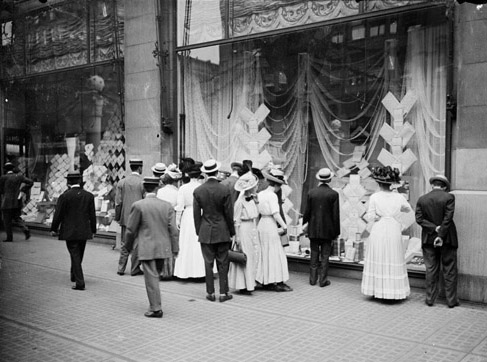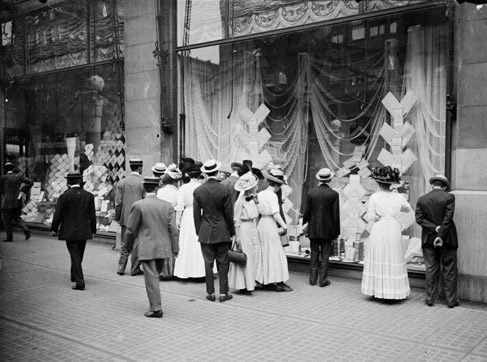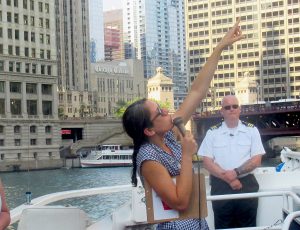A walk down State Street in downtown Chicago must inevitably the windows of this famed department store district. The Carson Pirie Scott Building, which we visit on the 1893 World’s Fair Tour, and Marshall Field’s – now Macy’s – which we visit on the Loop Interior Architecture Walking Tour, are a few of the many examples of how the motives of marketing and sales influenced the form of store architecture, particularly the development and use of the plate glass window. If it weren’t for the windows I probably wouldn’t even notice these stores along State Street.

What’s in a Window?
At the same time this structural transformation of department store buildings was happening in Chicago and New York. The internal structure of stores needed to be slender enough to permit maximum light and space throughout. Yet, at the same time, strong enough to bear the weight of all of the merchandise and customers. The amount of lighting merchandise received was most important. Previous buildings were bulky and due to the structure could not support large windows around the building’s periphery.
Department stores gave birth to the culture of consumption and set new trends for shopping. The availability of everything under one roof made it all seem tempting. These new, large windows functioned as advertising as they enticed buyers to come in. Department stores democratized consumption, making shopping available to customers regardless of their social or economic background. The large plate glass windows suggested to customers that they could enter without any obligation to buy. Considering the world of luxury and imagination these windows created, it is hard to believe at one time these stores did not have such a welcoming sight.
The Medium is the Message
The windows as a whole were often more important than the goods within them. In a book called Retailing: Critical Concepts, author Anne Findlay states, “they communicated festivity, vitality, beauty, and fantasy, revealing the signature of individual stores and the inner possibilities of store life.” The department store exercised their most immediate external appeal to potential customers through the window. Plate-glass windows, along with the windows of other consumer and business institutions, dramatically altered the appearance of city streets.
 Originally developed for enhancing displays in the late nineteenth century, plate glass windows became vital to the success of the department store in the early twentieth century. The ability to cheaply manufacture plate glass in the mid-1890s allowed these large picturesque windows to become a necessity. Store windows showed everything from bedroom sets to teacups, from lingerie to evening gowns, and I would imagine that in such a less image-saturated world of the early 1900s, in comparison to our times, these would have been quite a marvel.
Originally developed for enhancing displays in the late nineteenth century, plate glass windows became vital to the success of the department store in the early twentieth century. The ability to cheaply manufacture plate glass in the mid-1890s allowed these large picturesque windows to become a necessity. Store windows showed everything from bedroom sets to teacups, from lingerie to evening gowns, and I would imagine that in such a less image-saturated world of the early 1900s, in comparison to our times, these would have been quite a marvel.
~Brian Failing, Research & Collections Intern




















